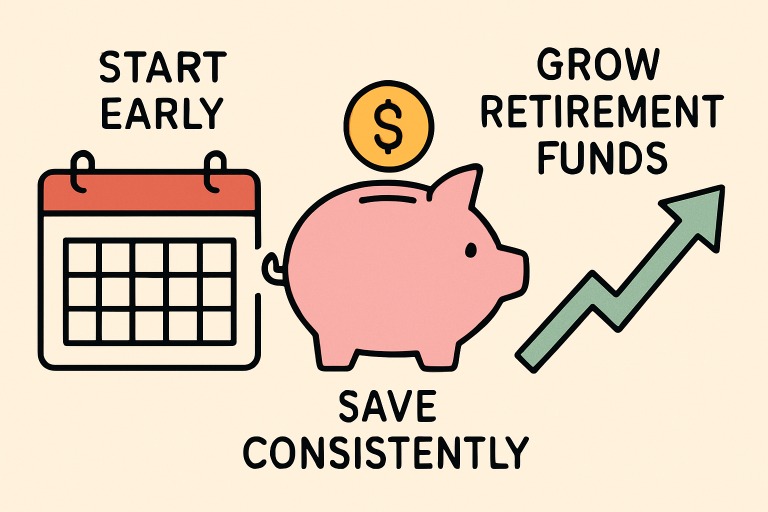Simple Steps to Start a Strong Retirement Plan Today
Key Takeaways
- Begin with a clear understanding of your retirement goals and needs.
- Create a realistic savings strategy that fits your timeline and finances.
- Utilize employer-sponsored plans and professional retirement plan providers for added benefits.
- Review and adjust your plan regularly to stay on track for a secure retirement.
Table of Contents
- Why Start a Retirement Plan Early?
- Define Your Retirement Goals
- Choose the Right Type of Retirement Account
- Finding a Reliable Retirement Plan Provider
- Take Advantage of Employer-Sponsored Plans
- Review and Adjust Your Plan Regularly
Why Start a Retirement Plan Early?
Planning for retirement might seem distant when you’re balancing the demands of work, family, and life’s daily challenges. However, starting early can profoundly affect your future financial well-being. The sooner you begin saving, the more you can take advantage of compound growth—where the interest you earn on your investments also starts earning interest. This snowball effect means even modest, regular contributions in your 20s or 30s can potentially grow into a substantial nest egg over several decades. Early planning allows your investments more time to recover from market fluctuations and helps spread risk, resulting in greater overall stability when you finally retire.
A retirement plan provider can be a valuable partner as you navigate this journey. These professionals offer guidance tailored to your situation, clarifying complex savings strategies and investment options. With their expertise, you’ll better understand tax advantages, rolling over accounts, or managing fees—all essential for building long-term wealth. Working with a provider increases your confidence and ensures your portfolio aligns with your evolving goals. The peace of mind from professional guidance and preparation will free you to focus on enjoying your current life without worrying about your future.
Define Your Retirement Goals
Before opening your first retirement account or contributing a portion of each paycheck, take some time to visualize your ideal retirement. Ask yourself what lifestyle you want in your later years—will you travel the world, move closer to family, start a new hobby, or perhaps volunteer part-time? Consider your aspirations and practical details, such as anticipated living expenses, healthcare costs, and whether you’ll carry any debt into retirement. Estimating a target retirement age and the yearly income you’ll need is crucial for developing the right strategy.
Using a dedicated tool can quickly show whether your savings trajectory can support your retirement plans based on your expected income, expenses, and retirement age. This information will help you set targets for your savings rate and clarify how much risk you might need to take. Honest goal-setting and realistic financial modeling are the foundation of every successful retirement plan.
Choose the Right Type of Retirement Account
There isn’t a one-size-fits-all solution, as different retirement accounts are designed for various life and work situations. The most common option for full-time employees is the 401(k), offered by many businesses. These plans often include the significant benefit of employer match contributions, which can be a powerful accelerator for building your savings. Suppose your employer doesn’t offer a plan or you’re self-employed. In that case, you can still choose from traditional IRAs, SEP IRAs, or Roth IRAs—each with unique tax advantages and contribution limits tailored to various needs.
For example, traditional IRAs allow you to make pre-tax contributions that grow tax-deferred, reducing your taxable income today but requiring you to pay taxes on withdrawals during retirement. Roth IRAs, by contrast, are funded with after-tax dollars, but qualified withdrawals are tax-free—a significant benefit for those who expect to be in a higher tax bracket later. Some individuals use a combination of accounts to maximize tax efficiency and flexibility. Research the rules associated with each plan, including penalties for early withdrawals and required minimum distributions. This knowledge will better position you to choose the right mix of accounts to meet both your short-term needs and long-term goals.
Finding a Reliable Retirement Plan Provider
Partnering with a reputable retirement plan provider is essential to maximizing your savings and investments. Providers are pivotal in helping you select the proper asset allocation based on age, risk tolerance, and financial goals. A good provider offers more than account management; they supply educational resources, robust digital tools, and straightforward advice about minimizing fees, which can quietly erode your returns over the decades.
When researching potential providers, prioritize transparency in all terms and costs. Seek organizations with strong customer support and helpful online portals that simplify monitoring your accounts. Providers with a proven track record in fund performance and various low-fee investment options should top your list. Consider asking friends, family, or financial advisors for recommendations, and always read client reviews and independent ratings before committing. Building a relationship with a trustworthy provider ensures your retirement savings are managed wisely, giving you confidence throughout your journey.
Take Advantage of Employer-Sponsored Plans
Employer-sponsored retirement plans are one of the most valuable benefits available to workers. If your employer offers a 401(k) or similar plan, make it a priority to enroll and contribute at least enough to capture the full company match. Employer contributions are essentially free money—few investment opportunities offer such an immediate, guaranteed return. Over decades, these matching funds can substantially boost your retirement savings when combined with your contributions and investment growth.
Many employers also provide financial education sessions, on-site plan representatives, and helpful materials to guide you through the enrollment and investment selection processes. Don’t hesitate to attend workshops, schedule one-on-one meetings, or ask questions about fees and investment options. Taking full advantage of these resources ensures you understand and use your plan to its highest potential.
Review and Adjust Your Plan Regularly
Retirement planning isn’t something you do once and forget. Your needs and circumstances can evolve over the years, so periodic reviews—ideally at least annually—are essential for staying on track. Check whether your current savings rate is adequate, especially if your income has changed, or if you’ve experienced key life events like marriage, buying a house, or the birth of a child. Use these milestones as reminders to increase your contributions or rebalance your investments.
It’s equally important to stay informed about changing laws, market conditions, and best practices. Major publications frequently provide updates and insight that can assist you in making informed decisions. If you’re unsure where to begin, consider meeting periodically with a financial advisor who can help you evaluate your performance and adjust your plan. Being proactive with your planning helps ensure your retirement goals remain achievable—regardless of changes.
Final Thoughts
Planning for retirement is not a one-time task but an ongoing process that requires foresight, flexibility, and consistency. Setting clear goals, choosing the proper accounts, leveraging employer-sponsored benefits, and working with trusted providers give you the best chance at long-term financial security. Regularly reviewing and adjusting your plan ensures it adapts to life’s changes while keeping you aligned with your future vision. Ultimately, a thoughtful and proactive approach to retirement planning allows you to enjoy peace of mind today and a more secure tomorrow.







